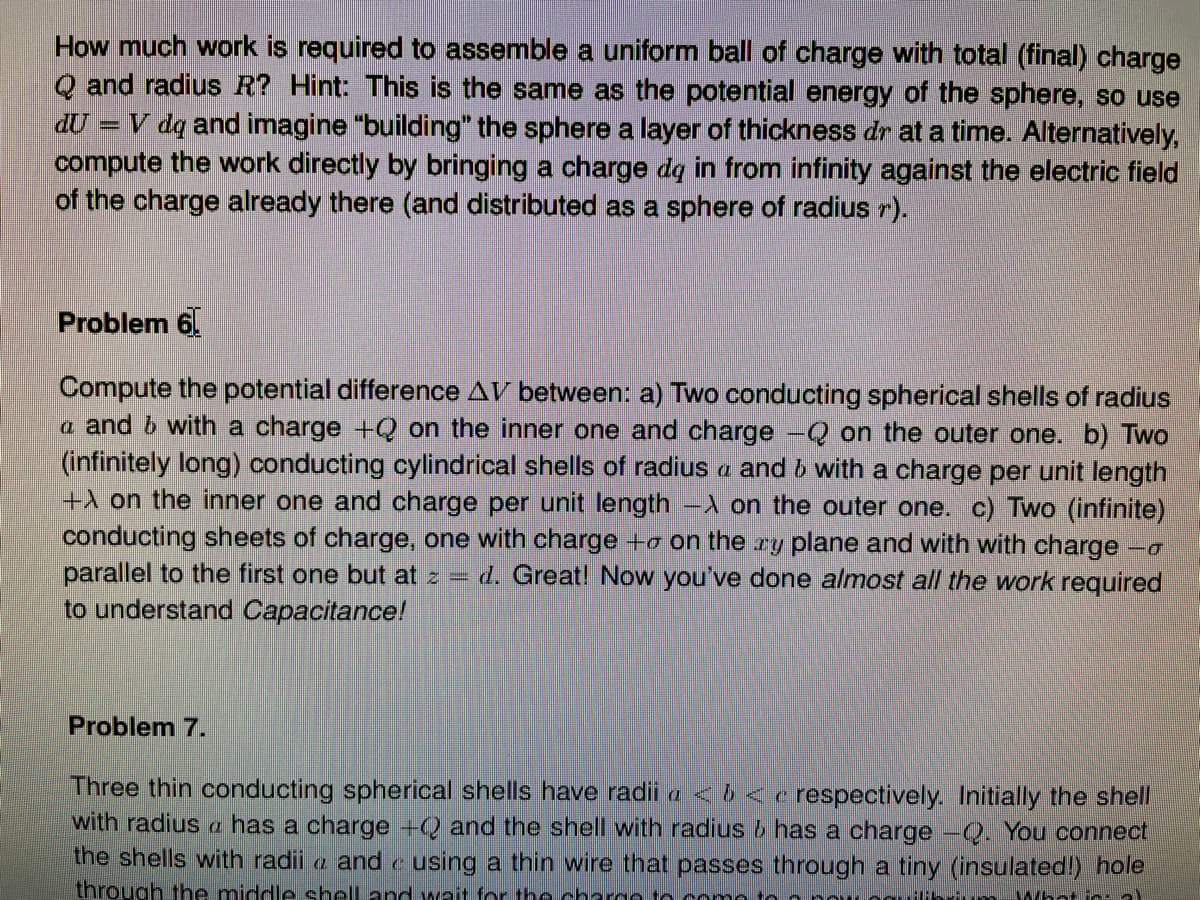Compute the potential difference AV between: a) Two conducting spherical shells of radius a and b with a charge +Q on the inner one and charge -Q on the outer one. b) Two (infinitely long) conducting cylindrical shells of radius a and b with a charge per unit length +A on the inner one and charge per unit length -1 on the outer one. c) Two (infinite) conducting sheets of charge, one with charge +o on the ry plane and with with charge parallel to the first one but at z = d. Great! Now you've done almost all the work required to understand Capacitance!
Compute the potential difference AV between: a) Two conducting spherical shells of radius a and b with a charge +Q on the inner one and charge -Q on the outer one. b) Two (infinitely long) conducting cylindrical shells of radius a and b with a charge per unit length +A on the inner one and charge per unit length -1 on the outer one. c) Two (infinite) conducting sheets of charge, one with charge +o on the ry plane and with with charge parallel to the first one but at z = d. Great! Now you've done almost all the work required to understand Capacitance!
Classical Dynamics of Particles and Systems
5th Edition
ISBN:9780534408961
Author:Stephen T. Thornton, Jerry B. Marion
Publisher:Stephen T. Thornton, Jerry B. Marion
Chapter5: Gravitation
Section: Chapter Questions
Problem 5.12P
Related questions
Question
Solve problem 6

Transcribed Image Text:How much work is required to assemble a uniform ball of charge with total (final) charge
Q and radius R? Hint: This is the same as the potential energy of the sphere, so use
đU = V dq and imagine "building" the sphere a layer of thickness dr at a time. Alternatively,
compute the work directly by bringing a charge dq in from infinity against the electric field
of the charge already there (and distributed as a sphere of radius r).
Problem 6.
Compute the potential difference AV between: a) Two conducting spherical shells of radius
a and b with a charge +Q on the inner one and charge -Q on the outer one. b) Two
(infinitely long) conducting cylindrical shells of radius a and b with a charge per unit length
+A on the inner one and charge per unit length -A on the outer one. c) Two (infinite)
conducting sheets of charge, one with charge +o on the ry plane and with with charge
parallel to the first one but at z =
to understand Capacitance!
d. Great! Now you've done almost all the work required
Problem 7.
Three thin conducting spherical shells have radii a < 6 < e respectively. Initially the shell
with radius a has a charge +Q and the shell with radius 6 has a charge -Q. You connect
the shells with radii a and e using a thin wire that passes through a tiny (insulated!) hole
through the middle shell and wnit for the chargo to como to
Thr m What in a)
Expert Solution
Step 1
Compute the potential difference between :
- Two conducting spherical shells of radius a and b with charge +Q (inner) and -Q (outer).
- Two conducting cylindrical shells of radius a and b with a charge per unit length + (inner) and (outer).
- Two conducting sheets of charge, one with charge on the x-y plane and with charge parallel to the first one, at z = d.
Concepts & Formulas :
Gauss's theorem states that "the total electric flux out of a closed surface is proportional to the electric charge enclosed by the surface".
Potential difference,
Step by step
Solved in 4 steps

Knowledge Booster
Learn more about
Need a deep-dive on the concept behind this application? Look no further. Learn more about this topic, physics and related others by exploring similar questions and additional content below.Recommended textbooks for you

Classical Dynamics of Particles and Systems
Physics
ISBN:
9780534408961
Author:
Stephen T. Thornton, Jerry B. Marion
Publisher:
Cengage Learning


Classical Dynamics of Particles and Systems
Physics
ISBN:
9780534408961
Author:
Stephen T. Thornton, Jerry B. Marion
Publisher:
Cengage Learning
